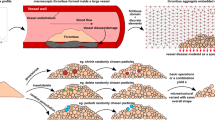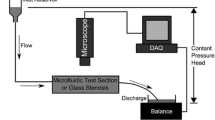Abstract
The paper presents a mathematical analysis of the contributions of flow and mass transport to a single reactive event at a blood vessel wall. The intent is to prepare the ground for a comprehensive study of the intertwining of these contributions with the reaction network of the coagulation cascade. We show that in all vessels with local mural activity, or in “large” vessels (d>0.1 mm) with global reactivity, events at the tubular wall can be rigorously described by algebraic equations under steady conditions, or by ordinary differential forms (ODEs) during transient conditions. this opens up important ways for analyzing the combined roles of flow, transport, and coagulation reactions in thrombosis, a task hitherto considered to be completely intractable.
We report extensively on the dependence of transport coefficient kL and mural coagulant concentration Cw on flow, vessel geometry, and reaction kinetics. It is shown that for protein transport, kL varies only weakly with shear rate\(\dot \gamma \) in large vessels, and not at all in the smaller tubes (d<10−2 mm). For a typical protein, kL∼10−3 cm s−1 within a factor of 3 in most geometries, irrespective of the mural reaction kinetics. Significant reductions in kL (1/10–1/1,000) leading to high-coagulant accumulation are seen mainly in stagnant zones vicinal to abrupt expansions and in small elliptical tubules. This is in accord with known physical observations. More unexpected are the dramatic increases in accumulation which can come about through the intervention of an autocatalytic reaction step, with Cw rising sharply toward infinity as the ratio of reaction to transport coefficient approaches unity. Such self-catalyzed reactions have the ability to act as powerful amplifiers of an otherwise modest influence of flow and transport on coagulant concentration.
The paper considers as well the effect on mass transport of transient conditions occasioned by coagulation initiation or pulsatile flow. During initiation, instantaneous flux varies with diffusivity and bulk concentration, favouring the early adsorption/consumption of proteins with the highest abundance and mobility. This is akin to the ‘Vroman effect’ seen in narrow, stagnant spaces. The effect of flow pulsatility on kL has the potential, after prolonged cycling, of bringing about segregation or accumulation of proteins, with consequences for the coagulation process.
Similar content being viewed by others
References
Aung, W. An experimental study of laminar heat transfer downstream of a back step. J. Heat Tr. 105:823–829; 1983.
Basmadjian, D. The hemodynamic forces acting on thrombi, from incipient attachment of single cells to maturity and embolization. J. Biomech. 17:287–298; 1984.
Basmadjian, D. The hemodynamic forces acting on thrombi. II. The effect of pulsatile flow. J. Biomech. 19:837–845; 1986.
Basmadjian, D. Embolization: Critical thrombus height, shear rates and pulsatility. Patency of blood vessels. J. Biomed. Mat. Res. 23:1315–1326; 1989.
Basmadjian, D., Sefton, M.V. A model of thrombin inactivation in heparinized and nonheparinized tubes with consequences for thrombus formation. J. Biomed. Mat. Res. 20:633–651; 1986.
Baughn, J.W.; Hoffman, M.A.; Takahashi, R.K.; Lee, D. Heat transfer downstream of an abrupt expansion in the transition Reynolds number regime. J. Heat Transfer 109:37–42; 1987.
Bergles, A.E. Survey and evaluation of techniques to augment convective heat and mass transfer. Progr. Heat Mass Transfer 1:331–424; 1969.
Bergles, A.E.; Nirmalan, V.; Junkhan, G.H.; Webb, R.L. Bibliography on augmentation of convective heat and mass transfer. Report HTL-31, ISU-ERI-Ames-84221. Heat Transfer Laboratory, Dept. of Mechanical Engineering, Iowa State University, Ames, Iowa 50011; 1983.
Chandran, K.B.; Yearwood, T.L. Experimental study of physiological pulsatile flow in a curved tube. J. Fluid Mech. 111:59–85; 1981.
Choi, U.S.; Talbot, L.; Cornet, I. Experimental study of wall shear rates in the entry region of a curved tube. J. Fluid Mech. 93:564–589; 1979.
Dravid, A.N.; Smith, K.A.; Merrill, E.W.; Brian, P.L.T. Flow heat transfer in helically coiled tubes. AIChE J. 17:1114–1122; 1971.
Dumas, A.; Barozzi, G.S. Laminar heat transfer to blood flowing in a circular duct. Int. J. Heat Mass Transfer 27:391–398; 1984.
El Masry, O.A.; Feuerstein, I.A. Electrochemical surface shear rate evaluation in models of the renal artery. J. Biomech. Eng. 104:290–295; 1982.
Goldsmith, H.L.; Turitto, V.T. Rheological aspects of thrombosis and haemostasis: Basic principles and applications. Thromb. Haemost. 55:415–435; 1986.
Grabowski, E.F.; Friedman, L.I.; Leonard, E.F. Effects of shear rate on the diffusion and adhesion of blood platelets to a foreign surface. Ind. Eng. Chem. Fundam. 11:224–232; 1972.
Grassman, P.P.; Tuma, M. Applications of the electrolytic method II. Mass transfer within a tube for steady, oscillating and pulsating flows. Int. J. Heat Mass Transfer 22:799–804; 1979.
Kalb, C.E.; Seader, J.D. Heat and mass transfer phenomena for viscous flow in curved tubes. Int. J. Heat Mass Transfer 15:801–817; 1972.
Krasuk, J.H.; Smith, J.M. Mass transfer in a pulsed column. Chem. Eng. Sci. 18:591–598; 1963.
Lutz, R.J.; Cannon, J.N.; Bischoff, K.B.; Dedrick, R.L.; Stiles, R.K.; Fry, D.L. Wall shear stress distribution in a model canine artery during steady flow. Circ. Res. 41:391–399; 1977.
Lutz, R.J.; Hsu, L.; Menawat, A.; Zrubek, J.; Edwards, K. Comparison of steady and pulsatile flow in a double branching arterial model. J. Biomech. 16:753–766; 1983.
Miller, G.E.; Hollis, T.M. Wall shear stress in the aorta. Chem. Eng. Commun. 7:113–119; 1980.
Mizushina, T. The electrochemical method in transport phenomena. In: Irvin, T.F.; Hartnett, J.P., eds. Adv. Heat Transfer 7:87–161; 1971.
Nandy, S.; Tarbell, J.M. Flush-mounted hot film anemometer accuracy in pulsatile flow. J. Biomech. Eng. 10:228–231; 1986.
Runchal, A.K. Mass transfer investigation in turbulent flow downstream of sudden enlargement of a circular pipe for very high schmidt numbers. Int. J. Heat Mass Transfer 14:781–792; 1971.
Schenk, J.; Han, B.S. Heat transfer from laminar flow in ducts with elliptical crossection. Appl. Sci. Res. 17:96–114; 1967.
Shah, R.K.; London, A.L. Laminar flow forced convection in ducts. Adv. Heat Transfer Supplement I. NY: Academic Press; 1978.
Solbrig, C.W.; Gidaspow, D. Convective diffusion in a rectangular duct with one catalytic wall, laminar flow, arbitrary reaction order. AIChE J. 13:346–351; 1967.
Soliman, M; Chambré, P.L. On the time-dependent Lévêque problem. Int. J. Heat Mass Transfer 10:169–180; 1967.
Talbot, C.; Steinert, J.J. The frequency response of electrochemical wall shear probes in pulsatile flow. J. Biomech. Eng. 109:60–64; 1987.
Tang, G.; Rosing, J.; Berretini, M.; Lammle, B.; Griffin, J.H. Autoactivation of human plasma prekallikrein. J. Biol. Chem. 262:11308–11319; 1987.
Thum, T.F.; Diller, T.E. Mass transfer in recirculating blood flow. Chem. Eng. Comm. 47:93–112; 1986.
Tuma, M. Untersuchung des Stoffaustausches bei pulsierenden Rohr-Stroemungen mit einem elektrolytischen Verfahren. Dissertation, ETH Zurich, Switzerland; 1977.
Turitto, V.T.; Baumgartner, H.R. Platelet deposition on subendothelium exposed to flowing blood; Mathematical analysis of physical parameters. Trans. Amer. Soc. Artif. Int. Organs 21:593–600; 1975.
Turitto, V.T.; Weiss, H.J.; Baumgartner, H.R.; Badimon, L.; Fuster, V. Cells and aggregates at surfaces. Ann. N.Y. Acad. Sci. 516:453–467; 1987.
Vroman, L.; Adams, A.L. Adsorption of proteins out of plasma and solutions in narrow spaces. J. Coll. Interfac. Sci. 111:391–402; 1986.
Walburn, F.J.; Stein, P.D. The shear rate at the wall in a symmetrically branched tube simulating the aortic bifurcation. Biorheology, 19:307–316; 1982.
Author information
Authors and Affiliations
Rights and permissions
About this article
Cite this article
Basmadjian, D. The effect of flow and mass transport in thrombogenesis. Ann Biomed Eng 18, 685–709 (1990). https://doi.org/10.1007/BF02368455
Received:
Revised:
Issue Date:
DOI: https://doi.org/10.1007/BF02368455




